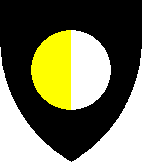Before we continue, did you catch that bit of vocabulary I snuck into the last section? To review, a charge is an item placed upon the shield. A field is the background of the shield. Clear so far? Great. This next part is rarely covered by traditional heraldic texts, and is usually where many non-heralds get lost.
A neutral charge or a neutral field is a charge or a field that is equally a metal (Or, argent) and a color (gules, azure, vert, purpure, sable). As long as neither of its tinctures matches the field underneath it, a neutral charge can go onto any tinctured field. Likewise, so long as the tincture of the charge on it doesn’t match either of its tinctures, a neutral field can have any tinctured charge on it.
Both charges and fields can be more than one tincture without being neutral. A charge can be split azure and gules, for example. But it cannot go onto a field that is a solid color (gules, azure, vert, purpure, sable) or a field that is split between two non-metals.
There is a special method of having both the field and the charge split along the same line, using the same color and metal. This process is called counterchanging, and flips the color and metal of the background on the charge, giving a striking effect. This is a special circumstance; since the color part of the charge only touches the metal part of the field, and vice versa, they can keep contrast while being the same tinctures.
Some examples:

Yes, because the field has both a metal and a color, and neither of them matches the charge gules.

Yes, because the charge has both a metal and a color, and neither of them matches the field azure.

Yes, because the charge is two colors, and the field is a metal.

Yes, because the charge is two metals, and the field is a color.

Yes, because the charge has been counterchanged. The sable doesn’t overlay the sable, and the Or doesn’t overlay the Or.

No. This is a color (well, two colors) on a color, and breaks the rule of tincture.

No. This is two colors on two colors, and therefore breaks the rule of tincture.